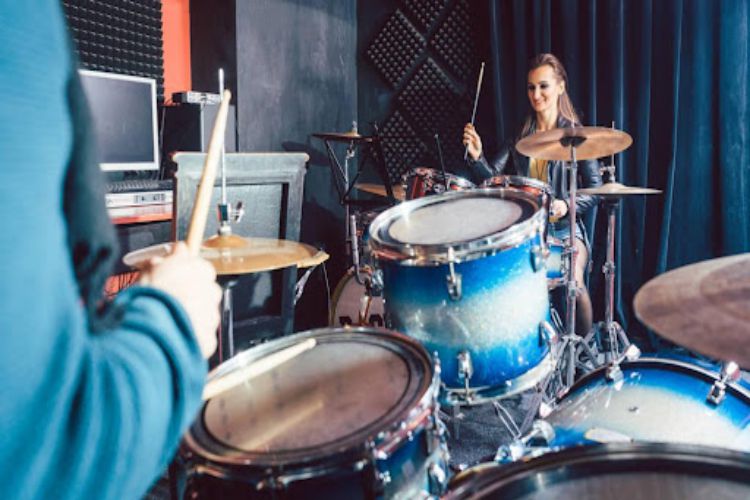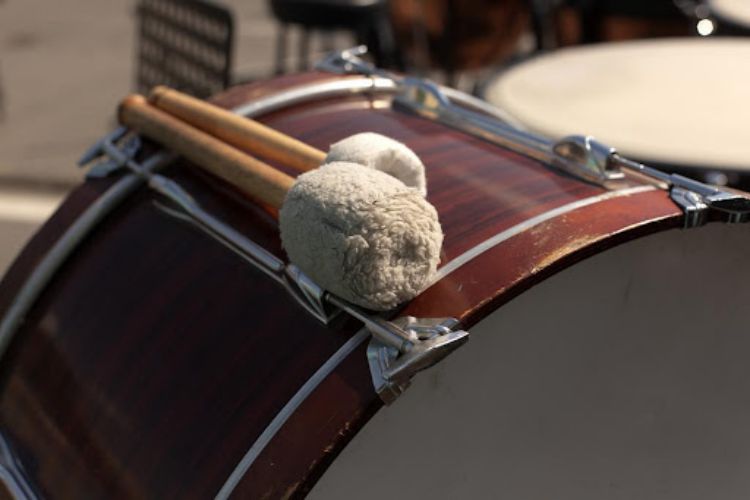Introduction
Welcome to your drum lesson! Whether you’re a beginner or an experienced drummer, this lesson will help you hone your skills and become a better percussionist. Today, we’ll be focusing on fundamental techniques such as hand and foot placement, reading music notation, developing coordination between hands and feet, learning fills and grooves, as well as building endurance. By the end of this session, you should have a better understanding of how to play drums in various musical styles. So grab your sticks and let’s get started.
 Drum Kit Overview: Types of Drums and Cymbals
Drum Kit Overview: Types of Drums and Cymbals
Aspiring drummers and experienced percussionists can find a wide range of drums and cymbals to choose from when selecting a drum kit. Before you start a drum lesson, it’s important to select the right drum set. There are different types of drums, cymbals, and other accessories available for different styles of playing. Knowing the various features and specs of each type can help you select the best drum kit for your needs.
Bass Drum: This is the heart of any drum set, consisting of a large cylindrical shell covered in either plastic or animal skin heads that are stretched over the top and bottom. Bass drums produce low-pitched tones with deep resonance due to their size, usually ranging from 18” to -26” in diameter. Different sizes offer different sounds – larger bass drums provide more power while smaller ones have more focus on high frequencies.
Snare Drum: The snare drum is one of the most important elements in any kit as it provides strong backbeats used to keep time during songs. It has two heads – one on top (batter head) which is struck with sticks or brushes to produce sound, while the bottom head (resonant head) produces a higher-pitched tone when struck or vibrated by its snares (metal wires). Its size typically ranges between
Basic Techniques and Exercises for Drummers
Drumming is an enjoyable activity that requires skill and practice to master. It can take a lot of time and dedication to learn the basics, but once you get the hang of it, it’s a blast! To help you on your journey, here are two basic techniques and exercises for drummers.
 Holding the Drumsticks Properly
Holding the Drumsticks Properly
The way in which you hold your drumsticks is essential for playing correctly. It helps you move around with ease while playing different rhythms and patterns. When holding your drumsticks, try to make sure they are parallel with each other and pointing away from your body. Keep them close together as well so that they don’t slip out of your hands easily when striking the drums or cymbals. Experiment with different grips to find what works best for you!
Posture and Positioning
Proper posture is key when playing the drums. Try sitting upright on a stool or chair with both feet firmly planted on the ground as this provides stability while playing complex rhythms.
Practice Strategies
Practice Strategies are an important part of any learning process and can be used to facilitate the learning of new skills. Whether you are trying to learn a language, a musical instrument, or a sport, having good practice strategies in place can help ensure that you make the most out of your practice time. Here are some tips for getting the most out of your practice sessions.
- Set Goals: Before beginning any practice session, it is important to have clear goals in mind. Knowing what skills you hope to gain from your practice session will help ensure that you stay focused throughout and don’t drift off into unrelated topics or activities. These goals should be specific and measurable so that you can track your progress over time and determine if what you’re doing is working for you or not.
- Break Up Your Practice: Long hours spent on one task can lead to fatigue and frustration very quickly. To avoid this, break up your practice into smaller chunks with breaks between each one so that your concentration levels remain high throughout the entire session rather than fading at the end due to exhaustion or boredom.
- Get Feedback: If possible, enlist someone else’s opinion on your progress during each session as this can provide valuable feedback which will allow you.
Developing Groove and Feel
If you are a musician, developing groove and feel is an essential part of your craft. In fact, it is the key to creating great music. Groove and feel are the two components that make up a song’s rhythm and help create an interesting musical experience for listeners.
Groove refers to the steady, consistent beat of a song that helps keep it moving along. It is important to develop a strong sense of groove in order to ensure that the overall sound has energy and momentum. When playing with others, having a good groove can also help unify everyone’s playing so they all sound like they are part of one cohesive unit. To develop your own sense of groove, practice playing simple beats on different instruments or sounds until you have a comfortable level of consistency when creating rhythms.
Feel is another important component in making music that connects with listeners emotionally through its rhythm and tempo. Feel involves being able to manipulate tempo or speed up or slow down certain sections in order to emphasize certain parts of the song more than others—such as during solos or chorus sections—or even just give songs more overall dynamic range by letting them breathe in certain areas before picking back up again afterward for dramatic effect.
Playing along with Music
Music has become an integral part of our lives. We listen to music while we work, relax, and even when we’re out and about. But for some people, listening to music is not enough – they want to be able to play along with it.
Playing along with music can be a great way to learn how instruments are used in creating the sound you enjoy listening to. It can also help improve your skills on a particular instrument as well as give you a chance to express yourself creatively. Whether you’re playing along with a guitar or simply tapping your feet in time with the beat, playing along with music can give you an intimate connection with it that just isn’t possible by simply listening.
If you’re new to playing along with music, there are several ways that can make it easier for you. Many popular songs have been simplified so that anyone can play them without being an experienced musician; these versions are often referred to as “simplified arrangements” or “arrangements for beginners”. You may also find versions of songs transcribed into tablature (a form of musical notation) or chord charts which provide diagrammed notes showing exactly what chords should be played at each section of the song;
Conclusion
Drum lessons can be an exciting, creative, and rewarding experience for all ages. They provide a great opportunity to learn the fundamentals of rhythm and music theory, as well as give students the chance to explore their own creativity. With practice and dedication, drummers can develop their skills over time and become skilled musicians. Drumming is a skill that can bring joy to many people for years to come.




